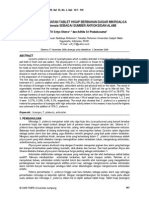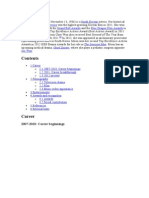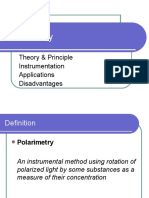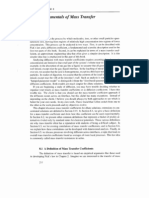Total Bilirubin L3K Assay: Genzyme Diagnostics P.E.I. Inc
Total Bilirubin L3K Assay: Genzyme Diagnostics P.E.I. Inc
Uploaded by
Pikiy PutriCopyright:
Available Formats
Total Bilirubin L3K Assay: Genzyme Diagnostics P.E.I. Inc
Total Bilirubin L3K Assay: Genzyme Diagnostics P.E.I. Inc
Uploaded by
Pikiy PutriOriginal Description:
Original Title
Copyright
Available Formats
Share this document
Did you find this document useful?
Is this content inappropriate?
Copyright:
Available Formats
Total Bilirubin L3K Assay: Genzyme Diagnostics P.E.I. Inc
Total Bilirubin L3K Assay: Genzyme Diagnostics P.E.I. Inc
Uploaded by
Pikiy PutriCopyright:
Available Formats
Genzyme Diagnostics P.E.I. Inc.
70 Watts Avenue, Charlottetown, PE Canada C1E 2B9 Tel: 800-565-0265 902-566-1396 Fax: 902-628-6504 Email: peidiagnostictechnical@genzyme.com www.genzymediagnostics.com
TOTAL BILIRUBIN L3K ASSAY
CATALOGUE NUMBER: 285-10 285-30 285-50A 285-50B SIZE: R1: 1 x 100 mL, R2: 1 x 25 mL R1: 3 x 100 mL, R2: 1 x 75 mL R1: 1 x 1000 mL R2: 1 x 300 mL
INTENDED USE For the IN VITRO quantitative measurement of bilirubin (total) in serum. TEST SUMMARY Bilirubin is a bile pigment normally found in serum as a result of red cell destruction. It is a product of hemoglobin breakdown by the reticuloendothelial system and exists in two forms. Unconjugated (indirect) bilirubin is transported to the liver bound by albumin where it becomes conjugated (direct) with glucuronic acid and excreted. The elevation of total serum bilirubin may occur due to hemolytic processes, liver disease, or a disorder of the biliary tract. Traditional methods of measuring bilirubin are based on the reaction of bilirubin with a diazo reagent to form the colored compound: azobilirubin. The diazo reaction can be accelerated by the addition of various chemicals. For example, Malloy-Evelyn (1) used ethanol, JendrassikGrof(2) used caffeine, and Walters-Gerarde(3) used DMSO. Modifications of these methods included the addition of surfactants as solubilizing agents(4). In this method, a 2,4-dichlorophenyldiazonium salt is used as the diazo reagent and the reaction is facilitated by the use of a surfactant. TEST PRINCIPLE Total Bilirubin +2,4-dichlorophenyldiazonium salt Surfactant
Azobilirubin
Bilirubin (conjugated and unconjugated) couples with the diazo reagent in the presence of a surfactant to form azobilirubin. The increase in absorbance at 546 nm is directly proportional to the total bilirubin concentration. REAGENTS Total Bilirubin L3K Accelerator Reagent (R1): A solution containing 154 mmol/L NaCl, 190 mmol/L HCl, surfactants, and preservatives. Total Bilirubin L3K Diazo Reagent (R2): A solution containing 417 mmol/L HCl, 5 mmol/L 2,4 dichlorophenyldiazonium salt and a surfactant. WARNINGS & PRECAUTIONS FOR USE Avoid ingestion. S24/25: Avoid contact with skin and eyes. See Material Safety Data Sheet for additional information. REAGENT, PREPARATION, STORAGE & STABILITY Reagents are ready for use. Supplied reagents are stable at 2-8C until expiry date. REAGENT DETERIORATION The reagent solutions should be clear. Turbidity would indicate deterioration. DISPOSAL Reagents must be disposed of in accordance with all Federal, Provincial, State, and local regulations. SPECIMEN Fresh, clear, unhemolysed serum. The specimen must be protected from light. SAMPLE STORAGE Specimens may be stored at 2-8C for 3 days. Specimens may be stored frozen at minus 70C for up to 3 months(3). ANALYTICAL SPECIFICITY (CLSI EP7)(7) Cross contamination studies have not been performed on automated instruments. Certain reagent/ instrument combinations used in sequence with this assay may interfere with reagent performance and test results. The existence of, or effects of, any potential cross contamination issues are unknown.
Interferences from hemoglobin, lipemia and ascorbic acid were evaluated for this total bilirubin method on a Hitachi analyzer using a significance criterion of >10% variance from control. Concentration Conv. Units 0.97 mg/dL 0.85 mg/dL 0.86 mg/dL SI Units 16.6 mol/L 14.5 mol/L 14.7 mol/L Substance Tested Hemoglobin Ascorbic Acid Intralipid Concentration of Interferent Where Interference is Insignificant 1000 mg/dL 100 mg/dL 600 mg/dL 155 mmol/L 567.8 mol/L 1800 mg/dL (20.5 mmol/L) Simulated Triglycerides
A summary of the influence of drugs on assays may be found by consulting Young, D.S.(6) ANALYTICAL PROCEDURE MATERIALS PROVIDED Genzyme Diagnostics Total Bilirubin L3K reagents. MATERIALS REQUIRED (BUT NOT PROVIDED) 1. Automated analyzer capable of accurately measuring absorbance at appropriate wavelength as per instrument application. 2. Calibration material. 3. Quality Control materials. TEST CONDITION For the data presented in this insert, studies using this reagent were performed on an automated analyzer using an endpoint test mode, with a sample to reagent ratio of 1:79 and a wavelength reading of 546 nm. For assistance with applications on automated analyzers within Canada and the U.S., please contact Genzyme Diagnostics Technical Services at (800)565-0265. Outside Canada and the U.S., please contact your local distributor. CALIBRATION A total bilirubin calibrator is not included, however one should be used to calibrate the procedure. The frequency of calibration on automated systems is dependant on system and parameters used. QUALITY CONTROL A normal and abnormal concentration control should be analyzed as required in accordance with local, state, and federal guidelines. The results should fall within the acceptable range as established by the laboratory. CALCULATIONS The analyzer automatically calculates the total bilirubin concentration of each sample. TEST LIMITATIONS A sample with a total bilirubin concentration exceeding the linearity limit should be diluted with 0.9% saline and reassaying incorporating the dilution factor in the calculation of the value. REFERENCE INTERVALS(6) 0.2-1.0 mg/dL (3.4-17.1 mol/L) These values are suggested guidelines. It is recommended that each laboratory establish the normal range for the area in which it is located. PERFORMANCE CHARACTERISTICS Data presented was collected on an automated analyzer unless otherwise stated. RESULTS Bilirubin (Total) concentration is reported as mg/dL (mol/L). REPORTABLE RANGE (CLSI EP6)(7) The linearity of the procedure described is 30 mg/dL (513 mol/L). The limit of detection of the procedure described is 0.1 mg/dL (1.2 mol/L). This results in a reportable range of 0.1-30.0 mg/dL (1.2-513.0 mol/L). PRECISION STUDIES (CLSI EP5)(7) Total precision data was collected on two control sera using two lots of reagent in 40 runs conducted over 20 days. Concentration
mg/dL mol/L
Total SD
mg/dL mol/L
0.8 4.6
14.4 79.2
0.03 0.13
0.5 2.2
Total CV % 3.1 2.8
Concentration
mg/dL mol/L
Within Run SD
mg/dL
0.8 4.7
14.2 79.5
0.02 0.05
Within Run CV mol/L % 0.3 2.3 0.9 1.1
Within run precision data was collected on two control sera using each run 20 times in a single assay.
ACCURACY (CLSI EP9) (7) The performance of this method (y) was compared with the performance of a similar method (x) on a Roche/Hitachi analyzer. Forty samples ranging from 0.17 to 26.61 mg/dL (2.9 to 455.0 mol/L) gave a correlation coefficient of 0.9998. Linear regression analysis gave the following equation: This method = 1.05 (reference method) + 0.13 mg/dL (2.2 mol/L). These performance characteristics were generated in Genzyme Diagnostics laboratories using automated procedures unless otherwise stated. REFERENCES 1. 2. 3. 4. 5. 6. 7. Malloy H.T. and Evelyn, K.A., The Determination of Bilirubin with the Photoelectros Colorimeter., J. Biol. Chem. 119: 481-490 (1973). Jendrassik, L and Grof. P. Vereinfachte, Photometrische Methoden zur Bestimmung des Blubilirubins, Biochem. A. 297: 81-89 (1938). Walters, M. and Gerarde, H., An Ultramicromethod for the Determination of Conjugated and Total Bilirubin in Serum or Plasma, Microchem. J. 15: 231-243 (1970). Winsten, J. and Cehelyk, B., A Rapid Micro Diazo Technique for Measuring Total Bilirubin., Clin. Chem. Acta 25: 441-446 (1969). Burtis, C.A. and Ashwood, E.R. (Eds), Tietz Textbook of Clinical Chemistry, Second Edition, W.B. Saunders Co., Philadelphia (1994). Young, D.S., Effects of Drugs on Clinical Laboratory Tests, AACC Press, Washington, 1990. CLSI Method Evaluation Protocols, Clinical and Laboratory Standards Institute, Wayne, PA. Definitions for Symbols
All trademarks, brands, product names and trade names are the property of their respective companies. IN28510-5 October 22, 2009
You might also like
- EXPERIMENT 1 BASIC FLUID PROPERTIES 1 Converted Converted 1No ratings yetEXPERIMENT 1 BASIC FLUID PROPERTIES 1 Converted Converted 16 pages
- Albumin: OSR6102 4 X 29 ML R1 OSR6202 4 X 54 ML R1 OSR6602 4 X 173 ML R1No ratings yetAlbumin: OSR6102 4 X 29 ML R1 OSR6202 4 X 54 ML R1 OSR6602 4 X 173 ML R12 pages
- 174 - 13 UREA PDF - 28-Euro Procedure SheetNo ratings yet174 - 13 UREA PDF - 28-Euro Procedure Sheet2 pages
- Generic Name: Lipase Kit (Enzymatic Colorimetric Assay Method) Abbreviated name:LIP Order Information Cat. No. Package SizeNo ratings yetGeneric Name: Lipase Kit (Enzymatic Colorimetric Assay Method) Abbreviated name:LIP Order Information Cat. No. Package Size36 pages
- Generic Name: Unsaturated Iron Binding Capacity Kit (Colorimetric Method) Abbreviated Name: UIBC Order Information Cat. No. Package SizeNo ratings yetGeneric Name: Unsaturated Iron Binding Capacity Kit (Colorimetric Method) Abbreviated Name: UIBC Order Information Cat. No. Package Size35 pages
- Lab Policies Triglycerides - Cobas c501 Lab 4455No ratings yetLab Policies Triglycerides - Cobas c501 Lab 44554 pages
- Transferrin: OSR6152 4 X 7 ML R1 4 X 8 ML R2No ratings yetTransferrin: OSR6152 4 X 7 ML R1 4 X 8 ML R22 pages
- Bilirubin: (Total and Direct) Jendrassik GrofNo ratings yetBilirubin: (Total and Direct) Jendrassik Grof2 pages
- SGPT Serum Glutamic Pyruvic TransaminaseNo ratings yetSGPT Serum Glutamic Pyruvic Transaminase2 pages
- Generic Name:Immunoglobulin G Kit (Turbidimetry Method) Abbreviated Name:Igg Order Information Cat. No. Package SizeNo ratings yetGeneric Name:Immunoglobulin G Kit (Turbidimetry Method) Abbreviated Name:Igg Order Information Cat. No. Package Size34 pages
- Alkaline Phosphatase (Dea) : Manufacturer: Biolabo Sas100% (1)Alkaline Phosphatase (Dea) : Manufacturer: Biolabo Sas2 pages
- Generic Name: High Sensitivity C-Reaction Protein Kit Abbreviated name:HS-CRP Order InformationNo ratings yetGeneric Name: High Sensitivity C-Reaction Protein Kit Abbreviated name:HS-CRP Order Information36 pages
- Food Safety: Innovative Analytical Tools for Safety AssessmentFrom EverandFood Safety: Innovative Analytical Tools for Safety AssessmentUmile Gianfranco SpizzirriNo ratings yet
- Daftar Harga Produk Ogb Pt. Dexa Medica Produk OralNo ratings yetDaftar Harga Produk Ogb Pt. Dexa Medica Produk Oral4 pages
- Formulasi Pembuatan Tablet Hisap Berbahan Dasar Mikroalga: Spirulina Platensis Sebagai Sumber Antioksidan AlamiNo ratings yetFormulasi Pembuatan Tablet Hisap Berbahan Dasar Mikroalga: Spirulina Platensis Sebagai Sumber Antioksidan Alami10 pages
- Arabian Journal of Chemistry Volume Issue 2012 [Doi 10.1016%2Fj.arabjc.2012.04.011] Rather, Manzoor a.; Dar, Bilal a.; Sofi, Shahnawaz N.; Bhat, Bil -- Foeniculum Vulgare- A Comprehensive Review of Its Traditional Use, PhNo ratings yetArabian Journal of Chemistry Volume Issue 2012 [Doi 10.1016%2Fj.arabjc.2012.04.011] Rather, Manzoor a.; Dar, Bilal a.; Sofi, Shahnawaz N.; Bhat, Bil -- Foeniculum Vulgare- A Comprehensive Review of Its Traditional Use, Ph10 pages
- Pharmaceutical Formulations: (Put List of Tablets / Capsules / Syrup / Injection / Ointment)No ratings yetPharmaceutical Formulations: (Put List of Tablets / Capsules / Syrup / Injection / Ointment)9 pages
- Chemistry of Pectin and Its Pharmaceutical Uses: A ReviewNo ratings yetChemistry of Pectin and Its Pharmaceutical Uses: A Review23 pages
- 2.9.1. Disintegration of Tablets and CapsulesNo ratings yet2.9.1. Disintegration of Tablets and Capsules3 pages
- The Effect of Combination of Octadecanoic Acid Methyl Ester and Ribavirin Against Measles VirusNo ratings yetThe Effect of Combination of Octadecanoic Acid Methyl Ester and Ribavirin Against Measles Virus4 pages
- Spray Drying For The Production of Nutraceutical Ingredients-A ReviewNo ratings yetSpray Drying For The Production of Nutraceutical Ingredients-A Review12 pages
- Instruction Manual Delta 2013-06-07 Version1No ratings yetInstruction Manual Delta 2013-06-07 Version165 pages
- Polarimetry: Theory & Principle Instrumentation Applications DisadvantagesNo ratings yetPolarimetry: Theory & Principle Instrumentation Applications Disadvantages23 pages
- Journal of Power Sources: Steven W. Swogger, Paul Everill, D.P. Dubey, Nanjan SugumaranNo ratings yetJournal of Power Sources: Steven W. Swogger, Paul Everill, D.P. Dubey, Nanjan Sugumaran9 pages
- Aerugite - Aerugite Mineral Information and DataNo ratings yetAerugite - Aerugite Mineral Information and Data5 pages
- Preparation and Characterization of Immobilizing Radioactive Waste Glass From Industrial WastesNo ratings yetPreparation and Characterization of Immobilizing Radioactive Waste Glass From Industrial Wastes14 pages
- M ScOrganic Chemistry III IV SemestersyllabusNo ratings yetM ScOrganic Chemistry III IV Semestersyllabus12 pages
- Factors Affecting Preparation and Properties of Nanoparticles by Nanoprecipitation MethodNo ratings yetFactors Affecting Preparation and Properties of Nanoparticles by Nanoprecipitation Method5 pages
- Iriotec - 8850 - Merck - TDS (For Rest of The World) PDFNo ratings yetIriotec - 8850 - Merck - TDS (For Rest of The World) PDF2 pages
- Isolation, Extraction and Purification of Green Pigment From Actinomycetes0% (1)Isolation, Extraction and Purification of Green Pigment From Actinomycetes7 pages







































































































